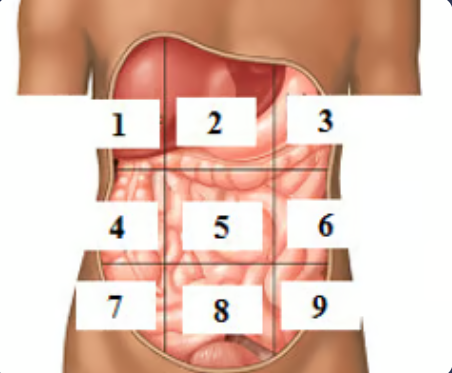sports med ch1 pt2 & ch2
0.0(0)
Card Sorting
1/74
There's no tags or description
Looks like no tags are added yet.
Study Analytics
Name | Mastery | Learn | Test | Matching | Spaced |
|---|
No study sessions yet.
75 Terms
1
New cards
Coronal (frontal) plane
Divides the body into anterior (front) and posterior (back) portions
2
New cards
Sagittal plane
Divides the body into lengthwise right and left portions
3
New cards
Transverse (horizontal) plane
Divides the body into superior (upper) and inferior (lower) portions
4
New cards
Oblique plane
Goes at an angle
5
New cards
Anatomical position
Body standing erect, facing forward, arms held to sides, palms of hands facing forward
6
New cards
Inferior
Below; neck is inferior to head
7
New cards
Superior
Above; thoracic cavity is superior to abdominopelvic cavity
8
New cards
Lateral
Toward the side; ears are lateral to the eyes
9
New cards
Medial
Toward the midline; my right shoulder is medial to my collarbone
10
New cards
Anterior (ventral)
Toward the front; eyes are anterior to the brain
11
New cards
Posterior (dorsal)
Toward the back; pharynx is posterior to the mouth
12
New cards
Bilateral
Paired structures; lungs are bilateral
13
New cards
Unilateral
One side; doing one arm at a time for shoulder press is unilateral
14
New cards
Distal
Further from point of attachment to trunk; fingers are distal to wrist
15
New cards
Proximal
Closer to point of attachment to trunk; elbow is proximal to wrist
16
New cards
Deep
More internal; dermis is a deep layer of the skin
17
New cards
Superficial
More external; epidermis is a superficial layer of the skin
18
New cards
Contralateral
Refers to structures on the opposite side of the body; right knee is contralateral to the left knee
19
New cards
Ipsilateral
Refers to structures on the same side of the body; right knee
20
New cards
Abdominal Regions
Regions of the abdomen including left hypo/chondriac, epi/gastric, right hypo/chondriac, left lumbar, umbilical, right lumbar, left iliac (inguinal), hypo/gastric, right iliac (inguinal)
21
New cards
Integumentary System
16% of adult body weight, made up of skin and accessory structures
22
New cards
Skin
Largest organ in the body by weight, first line of defense against the environment
23
New cards
Epidermis
Outer layer of skin, stratified squamous epithelium
24
New cards
Dermis
Inner layer of skin, much thicker than epidermis
25
New cards
Hypodermis/Subcutaneous Layer
Loose connective tissue below dermis, binds skin to organs underneath, mostly adipose tissue
26
New cards
Keratinocytes
Cells that produce fibrous protein keratin, protect skin, hair, nails; waterproof skin and keep out germs and chemicals
27
New cards
Melanocytes
Cells that produce pigment melanin, which gives skin, hair, and eyes their color
28
New cards
Ultraviolet (UV) Radiation
Sunlight contains significant amounts; small amounts beneficial, help produce vitamin D; larger amounts damage DNA, cause mutations, and promote cancer development.
29
New cards
Cyanosis
Blue skin color - low oxygenation of hemoglobin.
30
New cards
Erythema
Redness caused by fever, hypertension, inflammation, or allergy.
31
New cards
Jaundice
Yellow cast indicating a liver disorder.
32
New cards
Albinism
Genetic disorder, usually autosomal recessive, characterized by lack of melanin, resulting in extremely pale skin and hair, and blue to red, violet, hazel, or brown eyes.
33
New cards
Excessive Sun Exposure
Damages skin, causing leathery texture, immune system depression, and increased risk of skin cancer due to altered DNA.
34
New cards
Dendritic (Langerhans) cells
Macrophages that spot and capture germs, alerting the immune system and helping start the body's defense response.
35
New cards
Tactile (Merkel) cells
Sensory touch receptors that detect gentle touch and pressure, linking to nerve endings to send touch signals to the brain.
36
New cards
Fingerprints
Ridge patterns on top of each finger that are unique to each human, including identical twins, and help with grip.
37
New cards
Liposuction (Lipoplasty)
Used to remove excessive adipose tissue through a tube inserted deep to the skin, with complications including bleeding, infection, fluid loss, sensory loss, and risks related to anesthesia.
38
New cards
Psoriasis
Chronic inflammatory autoimmune skin condition characterized by thickened areas of silver-colored scales, most common on knees, elbows, scalp, lower back, face, palms, and soles.
39
New cards
Superficial papillary layer
Part of the dermis made of areolar tissue, capillaries, lymphatics, and sensory neurons.
40
New cards
Deeper reticular layer
Part of the dermis containing a meshwork of connective tissue, collagen, and elastic fibers, and all cells of connective tissue proper.
41
New cards
Dermal Processes
Processes from nerve cells throughout the dermis that include motor processes carrying messages from the brain to the skin's glands and sensory processes carrying messages from the skin back to the brain.
42
New cards
Sebaceous Glands
Specialized epidermal cells that secrete sebum, an oily mixture of fatty material and cell debris.
43
New cards
Holocrine glands
Glands that secrete their substance by the rupture of the entire cell.
44
New cards
Sebum
An oily mixture of fatty material and cell debris that inhibits bacterial growth and protects keratin of hair shafts.
45
New cards
Seat Glands
Also called sudoiferous glands, they include merocrine and apocrine glands.
46
New cards
Merocrine glands
Glands that secrete their products via exocytosis without losing cellular material.
47
New cards
Apocrine glands
Glands that lose part of their cell body during secretion.
48
New cards
Functions of the Integumentary System
Includes protection, body temperature regulation, cutaneous sensations, metabolic functions, blood reservoir, and excretion of wastes.
49
New cards
Vitamin D
Helps the body absorb calcium, which is necessary for heartbeats and skeletal muscle contraction.
50
New cards
Acid mantle
The low pH of skin secretions that decreases bacteria levels.
51
New cards
Dermicidin
A bactericidal substance found in sweat.
52
New cards
Defensins
Natural secretions that create holes in bacteria.
53
New cards
Normal body temperature
Regulated at 98.6°F (37°C).
54
New cards
Insensible perspiration
Sweat produced by sweat glands under normal resting body temperature, approximately 500ml/day.
55
New cards
Vasodilation
The widening of blood vessels that occurs when body temperature rises, leading to increased sweat production.
56
New cards
Arrector pili muscles
Muscles that contract to cause hair to stand on end, contributing to shivering in cold conditions.
57
New cards
Eczema (Atopic Dermatitis)
An immune-mediated skin inflammation that causes severe itching and is linked to genetics and environment.
58
New cards
Skin Cancer
May be caused by UV rays and is more common in fair-skinned and elderly individuals.
59
New cards
Basal Cell Carcinoma
The most common yet least dangerous type of skin cancer that begins in the stratum basale.
60
New cards
Squamous Cell Carcinoma
A type of skin cancer that begins in keratinocytes of the stratum spinosum and can metastasize.
61
New cards
Malignant Melanoma
The least common yet most dangerous type of skin cancer that often starts in melanocytes of pre-existing moles.
62
New cards
Burns
Leading causes of accidental death, which may occur due to fires, UV radiation, hot water, spills, radiation, strong acids or bases, and electrical shock.
63
New cards
Rule of nines
A method used to calculate the total body surface area affected by burns.
64
New cards
First-degree burns
Burns that affect the first layer of skin (epidermis), causing redness, pain, and slight edema.
65
New cards
Second-degree burns
Partial-thickness burns that affect the epidermis and dermis, leaving some of the dermis intact.
66
New cards
Third-degree burns
Burns that completely destroy the epidermis and dermis, often requiring skin grafts.
67
New cards
1
right hypochondriac region
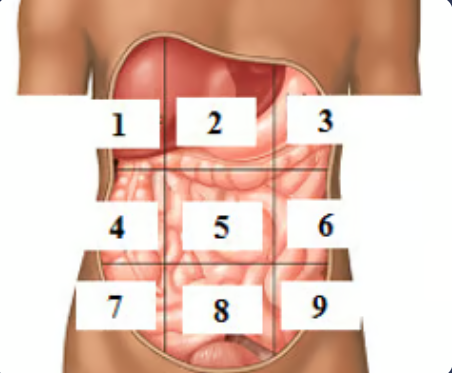
68
New cards
2
Epigastric
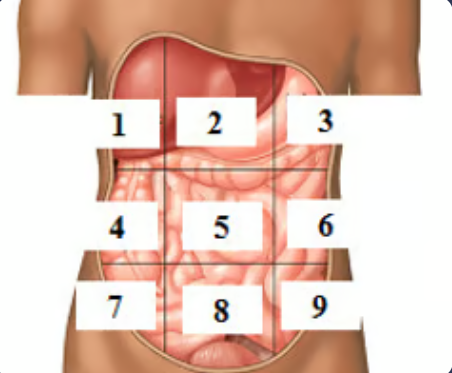
69
New cards
3
left hypochondriac region
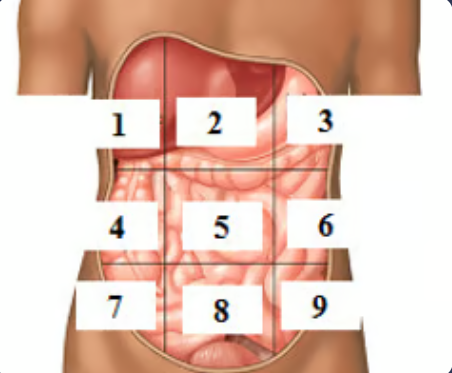
70
New cards
4
right lumbar
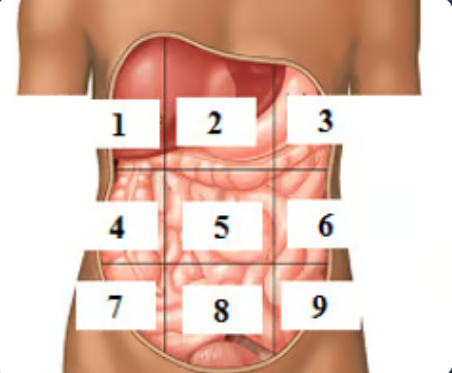
71
New cards
5
umbilical
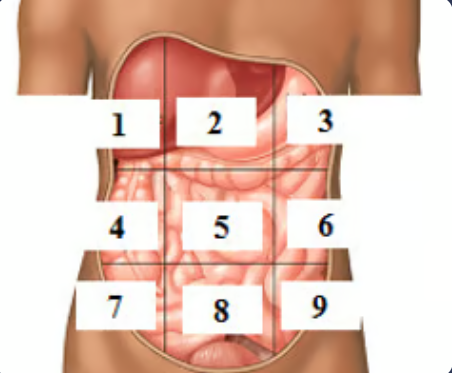
72
New cards
6
left lumbar
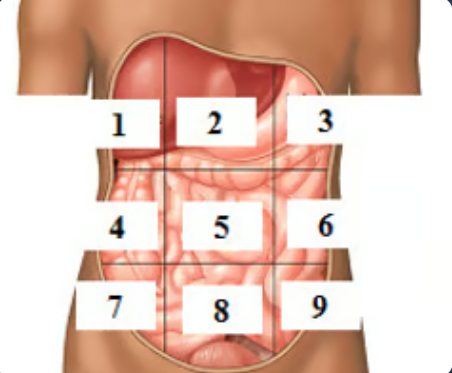
73
New cards
7
right iliac
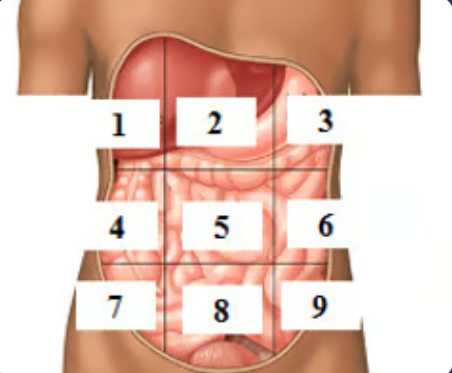
74
New cards
8
hypogastric
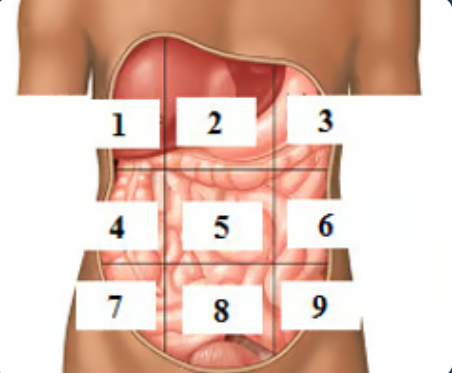
75
New cards
9
left iliac
